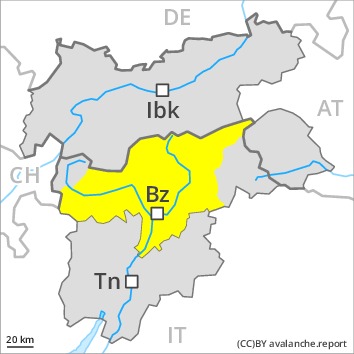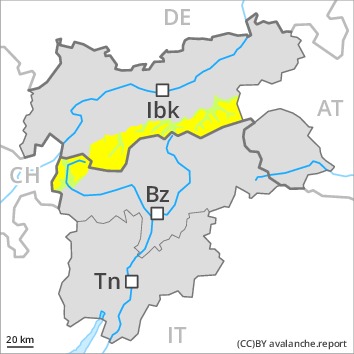
Danger level
 | 2400m
|
Avalanche Problem
 | | Wind-drifted snow |
|  | |  |
 | | Gliding snow |
|  | |  |

Old wind slabs in high Alpine regions. Individual gliding avalanches can also occur.
The older wind slabs remain in some cases prone to triggering in particular on northwest to north to northeast facing aspects above approximately 2400 m. They are to be found in particular adjacent to ridgelines and in gullies and bowls.
In isolated cases avalanches can be triggered in deep layers of the snowpack and reach quite a large size. Caution is to be exercised at transitions from a shallow to a deep snowpack. The prevalence of the avalanche prone locations will increase with altitude. In the Ortler Range the avalanche prone locations are more prevalent and the danger is greater.
On very steep grassy slopes and on sunny slopes only isolated gliding avalanches are possible, even quite large ones. Exposed parts of transportation routes can be endangered occasionally in the regions with a lot of snow.
Snowpack
dp.2: gliding snow
As a consequence of mild temperatures the snowpack settled. The snowpack is largely stable. The somewhat older wind slabs are in individual cases still prone to triggering. Towards its surface, the snowpack is fairly homogeneous and its surface has a crust that is barely capable of bearing a load, in particular on steep sunny slopes as well as at low and intermediate altitudes.
The old snowpack will be prone to triggering in some places. Faceted weak layers exist in the bottom section of the snowpack at high altitudes and in high Alpine regions.
Tendency
The avalanche danger will persist.

Danger level
 | 2600m
|
Avalanche Problem
 | | Gliding snow |
|  | |  |
 | | Wind-drifted snow |
|  | |  |

Caution is to be exercised in areas with glide cracks.
The danger of gliding avalanches will persist. On very steep grassy slopes and on sunny slopes more gliding avalanches are possible, even quite large ones. Areas with glide cracks are to be avoided.
The wind slabs of last week are to be evaluated with care and prudence in particular on northwest to north to northeast facing aspects above approximately 2600 m. These can still be released in particular on near-ridge shady slopes.
Snowpack
dp.2: gliding snow
dp.6: cold, loose snow and wind
Towards its surface, the snowpack is fairly homogeneous. As a consequence of mild temperatures the snowpack settled. The snowpack is largely stable and its surface has a melt-freeze crust that is barely capable of bearing a load, in particular on very steep sunny slopes, as well as at low and intermediate altitudes.
The old snowpack will be unfavourable in some places. Towards its base, the snowpack is faceted.
Tendency
Gradual decrease in avalanche danger.

Danger level
 | 2600m
|
Avalanche Problem

Old wind slabs in the high Alpine regions.
The older wind slabs remain in some cases prone to triggering in particular on northwest to north to northeast facing aspects above approximately 2600 m. They can only be released by large loads in most cases.
On very steep grassy slopes and on sunny slopes only isolated gliding avalanches are possible. Areas with glide cracks are to be avoided.
In very isolated cases avalanches can be triggered in deep layers of the snowpack. This applies on steep, rather lightly snow-covered shady slopes, as well as in extremely steep terrain in particular above approximately 2200 m. Caution is to be exercised at transitions from a shallow to a deep snowpack. In regions neighbouring those that are subject to danger level 3 (considerable) the avalanche prone locations are more prevalent.
Snowpack
dp.6: cold, loose snow and wind
Towards its surface, the snowpack is fairly homogeneous. As a consequence of mild temperatures the snowpack settled. The snowpack is largely stable and its surface has a melt-freeze crust that is barely capable of bearing a load, in particular on very steep sunny slopes, as well as at low and intermediate altitudes.
The old snowpack will be unfavourable in some places. Towards its base, the snowpack is faceted.
Tendency
Slight decrease in avalanche danger.











